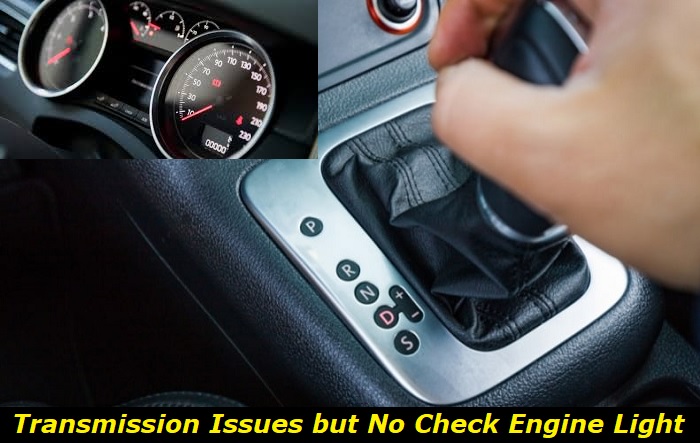One of the main symptoms of a transmission problem is the lighting up of the check engine on the dashboard. But without the check engine light coming on, it can be challenging to diagnose a transmission problem. This article will cover why that happens, how to diagnose transmission problems without the check engine light, and how to fix the transmission problems. Let's start with a look at how the transmission system functions.
Automatic transmission malfunction highlights
- Level of importance:Medium
- Reasons:Electronic control problems, shifter issues, sensor-related issues
- Needed expertise:High
- Needed tools:Professional tools set
- Time taken:1-8 hours
- Can you drive? Not recommended
- Possible issues: Fatal damage, overheating, torque converter damage, TCU damage.

What's the Function of the Transmission System?
The power transmission system consists of components such as a clutch, gearbox, propeller shafts, drive shafts, and the engine that work harmoniously. These components transmit power from the engine to the crankshaft's rotary motion, which is then slowly transferred to the drive wheels. A transition ratio change allows a speed, torque, and direction switch.
The transmission system can either be automated or manual. In an automated transmission system, the opening and closing of clutches and the switching between gears are electronically controlled. On the other hand, the driver shifts the gears through a gear lever next to the driver's seat or a paddle on the steering wheel in a manual transmission.
Components such as the gear serve to change the rotational speed of the drive wheel through a transmission. The clutch does the work of controlling the torque between the input and output shaft.
Reasons for Transmission Problems with No Check Engine Lights
The check engine light comes on when there's an engine or transmission problem and is crucial in alerting the driver of a possible issue. Whenever the check engine doesn't illuminate on the dashboard, it can be challenging to know if a transmission problem exists.
One can also assume that the transmission issue isn't severe and cause the issue to intensify. There are a couple of reasons why the check engine light might not illuminate in case your vehicle is experiencing a transmission problem. Some of these are:
- An Electrical Issue
If your vehicle has an electrical issue, such as a failing electrical component or a faulty transmission control module, shifting problems can arise without the check engine light illuminating. An electrical problem can result from corrosion, rust, or rodents which may lead to faulty electrical wiring. This eventually leads to drivability issues.
- Engine Complications
Another issue that may prevent the check engine light from coming on whenever there's a transmission issue also is complications with the engine. Problems related to the engine can prevent the engine control module (ECM) from allowing the transmission system to shift to higher gears.
Engine issues such as misfiring and stalling when idling can, in the long run, lead to transmission slipping without the check engine light coming on. A communication problem between the transmission and engine system can also leave the car stuck in limp mode without the check engine light coming on.
- Transmission Issues
The final issue could be a transmission problem. Some transmission issues that lead to hard gear shifting cannot trigger the check engine light illuminating on the dashboard. Transmission problems such as a damaged clutch, a failing shift solenoid, and a lack of transmission fluid, aren't severe enough to trigger the check engine light to come on in the dashboard, in some car models.
How to Diagnose Transmission Problems without the Check Engine Light
If the check engine light doesn't illuminate on the dashboard, you can use other symptoms to correctly diagnose a transmission problem. Diagnosing transmission problems at their early stages can be of use to prevent further complications down the road that might be expensive to repair. Some of the symptoms of transmission problems are:
1) Unusual Noise
One of the telltale signs of an automatic transmission problem is strange sounds such as humming, clunking, and whining. These sounds come from underneath the car. For manual transmission, you'll hear loud machine-like sounds instead. The car can also exhibit a humming sound when the gear is in neutral.
You'll hear a clunking or squealing noise when shifting gears to signal a faulty transmission system. You may also hear a slipping or grinding sound whenever you shift gears. These noises can be attributed to a low or contaminated transmission fluid. Some transmission parts, like the gear teeth or bearings, may also be experiencing mechanical wear, making them faulty.
2) Delayed Shifting
Whenever there are stiff and jerky shifts, hesitation, or slow response whenever you shift gears, the issue is most likely a transmission problem. The delayed shifting can also be accompanied by noise when changing gears. A slow or no response happens, especially when you shift your vehicle from park to drive.
You'll experience some lag time whereby the car takes time before taking off and can even completely stall. In cars with a manual transmission, the delayed shifting can go along with an RPM (revolutions per minute) surge that isn't equal to your car's speed.
3) Strange Smells
Another sign of a faulty transmission system is a burning smell from the engine bay. This is due to the burning or overheating of the transmission fluid because of degradation or insufficient transmission fluid. The engine then starts corroding and becoming worn due to excess heat. A burning smell may also indicate a melting heater core, dripping antifreeze, and trapped plastic.
4) Low Transmission Fluid
If the transmission fluid goes below the required level due to leakage, transmission problems arise. Apart from lubricating various transmission parts, the transmission fluid also acts as a coolant, maintains hydraulic pressure to engage gears, conditions the gasket, and protects the transmission parts from rust or oxidation.
The hydraulic pressure reduces whenever the transmission fluid becomes low, causing gear slippage (lack of smooth shifting when driving). This eventually leads to reduced acceleration and high RPMs as the vehicle moves sluggishly.
5) Dragging Clutch
A dragging clutch is a typical transmission problem among manual vehicles. This occurs when you step on the clutch, and the disc fails to disengage from the flywheel. The clutch is then left spinning. This prevents the switching of gears, and you'll hear a grinding sound as you try to switch gears due to a lack of power transfer from the engine to the drive train.
6) Shaking and Jerkiness
Another common symptom of a faulty transmission is shaking after a gear shift which even prompted some manufacturers to conduct a recall. Mechanical wear of the transmission gear synchronizers and a worn-out clutch are some of the causes of the jerkiness. If the worn-out parts are not replaced, the wearing out of the gears can progress gradually until the jerking and shuddering intensify.
Causes of Transmission Problems
Various reasons can cause transmission problems. Some of them are:
- Malfunctioned Solenoid Valve
A solenoid valve is a small valve that opens and closes after receiving electrical signals to regulate the flow of the transmission fluid. When the valve fails, it cannot control the hydraulic pressure causing the transmission to slip.
- Clogged Transmission Filter
The transmission fluid cannot flow effectively when the transmission filter is clogged by dirt. This causes improper lubrication of the transmission parts, making the parts not work correctly.
- Damaged Gears
The transmission gear may wear out over time due to rigid gear engagement and overheating of the transmission fluid. The gear synchronizers in the manual transmission system may also wear out, causing a rough shifting experience.
- Faulty Torque Converter
A torque converter plays the role of transferring the rotating power from the power source, which in this case is an internal combustion engine, to a rotating driven load. It has the same function as a clutch in manual transmission. Failure of the torque converter causes improper shifting of the gears due to lack of enough hydraulic pressure.
Now that you know some causes of transmission problems, let's look at how you can fix them.
How to Fix Transmission Problems Missing the Check Engine Light
Fixing the transmission problems depends on the diagnosis you make in trying to find the specific issue. Some fixes include:
- Regularly inspecting the car for transmission fluid leaks. If you see a bright red fluid or red spots underneath the car, that is a sign of transmission fluid leakage. You need to seal the leaking spots and refill the fluid. Ensure you replace the contaminated fluid with fresh transmission fluid. Contaminated fluid looks dark and smells burnt.
- Inspect the gearbox and ensure it's well-lubricated. You should also replace worn-out gear
- If the transmission filter is clogged, you'll need to locate the transmission fluid or drain plug to drain the fluid. You'll then have to clean and reuse it.
- If a damaged solenoid valve is causing the failure of the transmission system, all you need to do is use an OBD II diagnostic tool to identify the faulty valve and replace it with a new one.
- A faulty torque converter needs the services of an experienced auto mechanic. This is because it requires proper diagnosis and replacement with a new part.
Bottom Line
There you have it - all about transmission problems without the check engine light coming on. If you cannot do a self-diagnosis, your next option would be to visit your nearest auto mechanic shop to get a viable solution.
About the authors
The CarAraC research team is composed of seasoned auto mechanics and automotive industry professionals, including individuals with advanced degrees and certifications in their field. Our team members boast prestigious credentials, reflecting their extensive knowledge and skills. These qualifications include: IMI: Institute of the Motor Industry, ASE-Certified Master Automobile Technicians; Coventry University, Graduate of MA in Automotive Journalism; Politecnico di Torino, Italy, MS Automotive Engineering; Ss. Cyril and Methodius University in Skopje, Mechanical University in Skopje; TOC Automotive College; DHA Suffa University, Department of Mechanical Engineering





Add comment